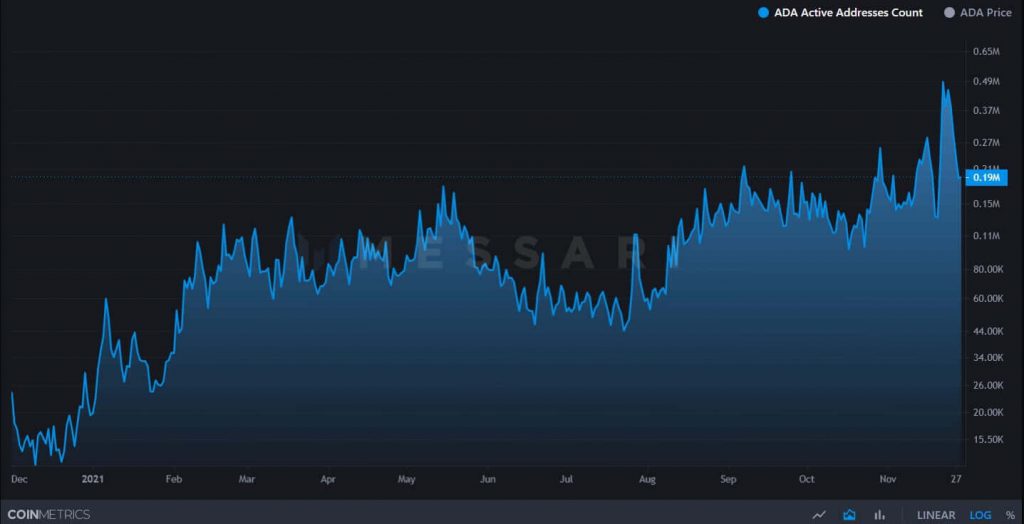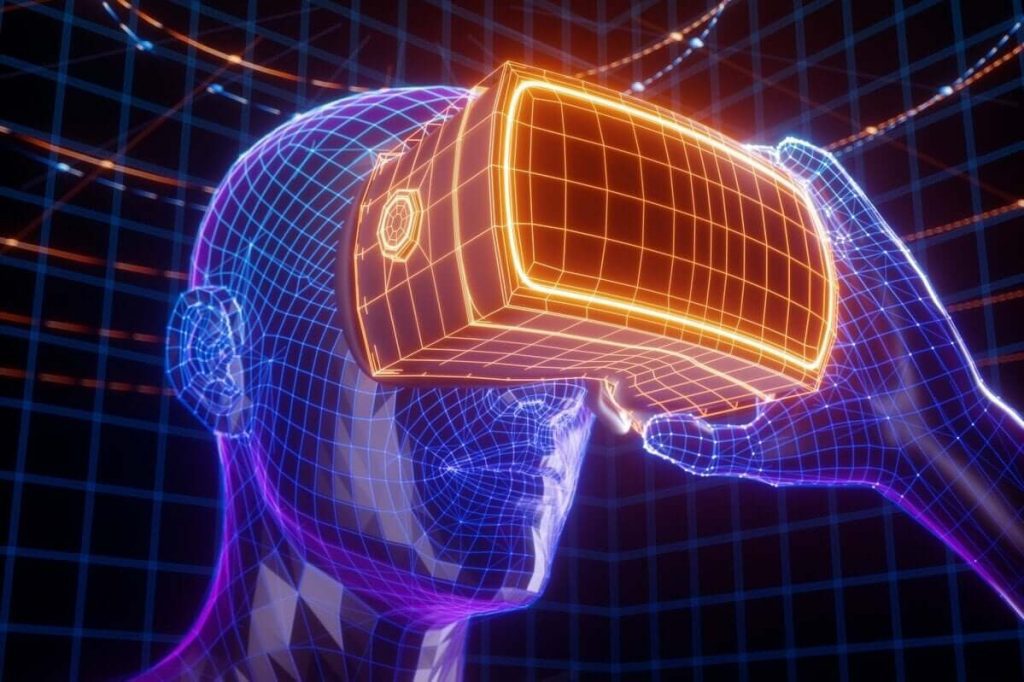This month, the number of active addresses on the Cardano network increased by more than 200 percent. On December 1, it debuts the new block size.
Cardano: New Block Size and The Metaverse. The number of Cardano active addresses increased by more than 25% in November 2021, according to Messari data. ADA’s active address count peaked at more than 485,000 but is now at just over 191,500. At the beginning of the month, the figure hovered around 161,000.

The Cardano network and its native ADA cryptocurrency have performed well this year after several updates. The most significant was the Alonzo update, which introduced Smart Contracts to the platform.
With Smart Contracts, the network has become much more capable and has led to many developments related to the DeFi space. Numerous DEXes, such as SundaeSwap, are currently in the pipeline, and developers are also working on other dApps.
A bright future for Cardano?
Cardano’s future looks pretty bright. Updates have boosted the network’s capabilities, and developers are embracing them. Indeed, there is new interest in developing the Cardano network.
There is also a noticeable increase in DeFi-related developments on Cardano. Ardadex became the first DEX and NFT marketplace on Cardano, and COTI is issuing a new stablecoin on the network. A new lending protocol, ADALend, will also become essential to the ecosystem.
A large part of Cardano’s success will come from the strength of its ecosystem. It seems well poised to at least serve as a viable alternative to Ethereum, which remains the king of the DeFi market.
Ethereum is also working on its technical improvements, so next-generation networks will quickly want to use their strengths to build a robust ecosystem.
12.5% block size increase
Input-Output Hong Kong (IOHK), the organization responsible for Cardano (ADA), announced that it would increase the size of blocks on the network. The change took place on the testnet last Thursday, November 25. In an announcement on Monday, November 22, IOHK said it is making changes to increase the processing capacity of the Cardano blockchain.
The cryptocurrency network, which recently surpassed Ethereum (ETH) in usage for a short period, is beginning the Basho phase of its roadmap for upgrades and enhancements. “Network optimization, size, and growth” will receive more attention.
Cardano’s blocks will have a 12.5% increase. More transactions can be grouped into a single block, increasing the network’s processing power. In addition, the block size would also increase from 8 KB to 72 KB.
Despite improving the network, the changes are considered simple compared to other protocols. In this regard, Cardano’s developers stated that they are opting for slower and steadier parameterization: “A 12.5% increase is considerable, but not very large, leaving room for further expansion and allows stake pool operators (SPO) to adjust to increasing demands.”
In addition to block sizes, there will also be an increase in Plutus script memory units, which are codes used to validate network actions. Each transaction will have 11.25 million units. With higher memory limits, script development will be more sophisticated, while current scripts can process more data elements.
According to IOHK, these changes went into effect on the testnet last Thursday, November 25. If all goes as expected, developers will apply the changes to the mainnet on December 1.
Cardano network growth
As highlighted in the announcement, changes are needed to increase the transferability of the network. The team responsible for the project also comments that they will preview the increase in network traffic, which has become increasingly intense following the Alonzo upgrade.
With the upgrade, Cardano began offering Smart Contract features. Since then, several projects have involved DeFi, decentralized exchanges (DEX), and NFT on the cryptocurrency blockchain. However, by some estimations, only 25% of the network capacity is being used, which is considered low. One of the reasons for this would be that the network is not as fast as other projects.
John Woods, current director of Cardano, assures that they will not make any new changes without extensive testing:
“While there will inevitably be people who want to move faster, our focus will remain on a stable and secure evolution as Cardano grows in scope and adoption.”
John Woods
Finally, IOHK also noted that there are currently “well over” two million wallets on Cardano, with network traffic increasing more than 20-fold in just one year.


Cardano CEO confident in Metaverse’s capabilities
Charles Hoskinson, CEO of Cardano, shared his stance regarding the profit relationship between the Metaverse and cryptocurrencies. Charles Hoskinson, CEO of Cardano (ADA), talked about his thoughts on the Metaverse and digital assets on the Thinking Crypto podcast.
He considered a scenario where real-life events and things link to the Metaverse to get technical benefits that broaden the crypto community’s possibilities.
The expansion of the digital world
There is a possibility that as more digital assets become available, the Metaverse will be able to accomplish its duties with more user participation. Hoskinson’s viewpoint demonstrates his support for the virtual world in this way. Regarding cryptocurrencies, Cardano’s CEO has shown himself in favor of the ecosystem. He pointed to the willingness of large companies to enter this industry fully.
He also discussed how the market is reacting to this industry. Many events happen simultaneously as these companies demonstrate their Metaverse-connected devices to the general public. Apple, for example, is planning to develop its augmented reality world.
NFTs Influence
Besides the Metaverse’s underlying structure, digital assets are essential to the new ecosystem’s utilization. Although NFTs have piqued more people’s attention in the Metaverse’s business prospects, a market segment remains skeptical.
Nonetheless, Cardano’s CEO reaffirmed his support for the industry’s expansion. The system would also incorporate non-fungible tokens and other assets. He agreed that people should understand these tokens as unique security identifiers that reflect real-world assets. He believes there should be some “control” in the new platforms that lend “logic” to the employment of NFTs. While a database links all these interactions, this is not the case.
Metaverse Relationship with the Real World
Charles Hoskinson believes that the services performed by digital assets and reality should be in sync. In this sense, the fiscal management system would complement the diversity that the digital world’s development would provide.
Despite Cardano’s CEO’s repeated approval of the new logistics, several community members are opposed. “As you somehow tax the digital and digitize the physical, you need cryptocurrencies to build a trust model and a scarcity model,” he continued.
I’ve noticed characteristics allowing users to expand their development skills in this Metaverse. Using the system would open doors for participants to navigate other business sectors beyond video games. “You can overlay the physical world with digital attributes. For example, when you look at a structure, such as a restaurant, it displays you what time it opens and shuts on your augmented reality glasses,” he explained.
